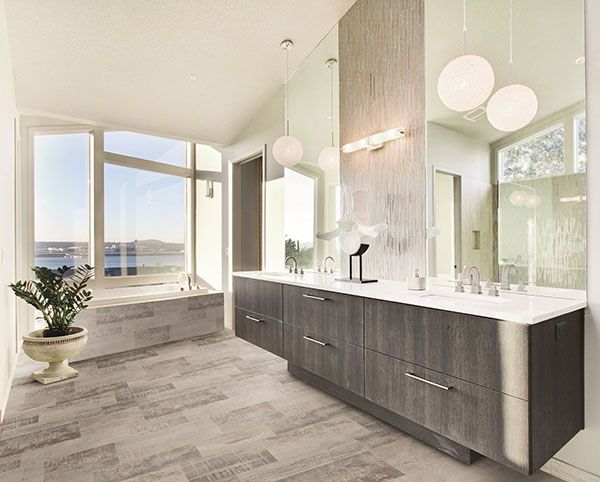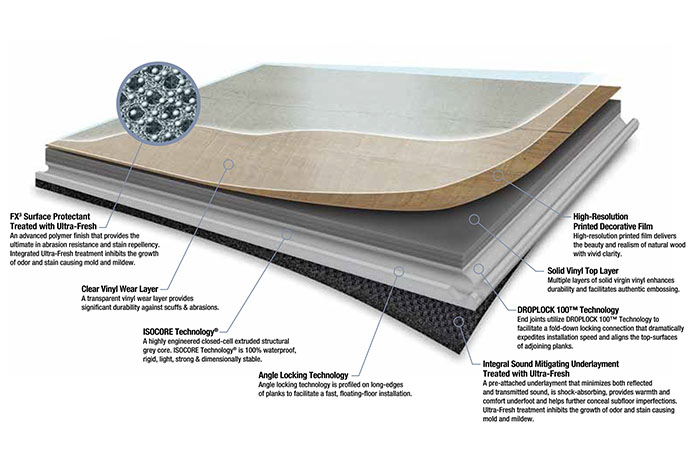Decoding Multi-Layer Flooring
Categories of vinyl flooring have emerged into a web of varied constructions that are referred to in acronyms, and are also referenced as “resilient.” Some can be cross-referenced into multiple definitions because manufacturers don’t always use consistent terminology. At Twenty & Oak, our goal is to help you understand the basic differences in product construction and performance so you can focus on selecting the right solution for your home and for your lifestyle.
-
There are four main types of layers in flooring: Wood Plastic Core (WPC) or Wood Composite Core (WCC), Composite Core (CC), Solid PVC, and Solid Polymer Core (SPC).
-
Vinyl sheet, sheet vinyl and vinyl rolls are available in a variety of sizes and are highly customizable to fit any size room.
-
The top layer of multi-layer flooring offers protection against scratches and normal wear and tear.
-
The above vinyl also vary in thickness and can offer a quiet underfooting.
Core Materials of Multi-layer Flooring
First, let’s break down the levels of multi-layer flooring. Whatever polymer-based plank or tile flooring you use, there will be one of four core materials included. Understanding these four cores will help you find the right flooring fit for the space.
-
Wood Plastic Core (WPC) or Wood Composite Core (WCC)–The perfect mix between laminate and vinyl, this is a blend of wood dust and PVC and is water-resistant. WPC is also a great option for those looking for a quiet underfoot.
-
Composite Core (CC)–While it lacks the wood fiber blend, this layer mixes PVC with calcium carbonate or other limestone filler. It’s waterproof while offering a lighter weight.
-
Solid PVC–This core material is much like composite core, but offers a different ratio of blended materials. It offers PVC resin to create a stronger substance.
-
Solid Polymer Core (SPC)–As opposed to plastics and PVCs, this core uses a stone or cement material for its base. SPC cores are quite strong and rigid, making them excellent for withstanding scratches and dents.
Four Levels of Multi-level Flooring
In addition to the materials used in multi-layer flooring, there are four levels that make up the flooring. Here is a basic breakdown of these four levels:
Layer 1–Top clear coat that resists scratches, offering extra durability.
Layer 2–Compressed vinyl layer that is often used for embossing or decorative films.
Layer 3–This layer is made of one of the four core materials mentioned above. To be water-resistant, it will need to be WPC or SPC.
Layer 4–This bottom base layer is made of foam or cork, offering a final barrier such as an attached pad to provide sound absorption or protection from floor heating systems.
Water-resistant Vinyl Flooring
For water-resistant, multi-layer flooring, there are two different types of water-resistant vinyl planks from which to choose: Wood Plastic Composite (WPC) and Solid Polymer Core (SPC).
However, while WPC and SPC are excellent water-resistant options for multi-layer flooring, they still require some maintenance. Simply be diligent and wipe spills quickly and keep water from pooling up in certain areas of your home.
Let’s take a more in-depth look at some of our water-resistant flooring options:
Vinyl sheet and vinyl rolls, as well as luxury vinyl planks (LVP) and luxury vinyl tiles (LVT).
Vinyl Sheet, Sheet Vinyl, or Vinyl Rolls
This is the easy category to understand. We are talking about a vinyl based product, produced in sheets, usually 12’ or 13’ 2” in width. Roll sizes can range from 55 – 120 square yards, depending on the overall weight of the product. The distributor or retailer can make cuts from the roll to accommodate individual orders for smaller space.

Almost all of the collections in this category are constructed of a fiberglass base layer and a foam layer that is injected with air and results in a soft, quiet solution underfoot. The print film that provides the design and color is topped with a wear layer that varies in thickness (mils/gauge) and is relative to the price, warranty and subsequent durability. A urethane finish layer that protects against scratches, scuffs and stains tops off the construction. For added sound absorption, water resistance and stability, consider Beauflor’s BlackTex HD collection which includes a textile backing and additional warranty features.
Luxury Vinyl Planks and Tiles (LVT and LVP)
Any product that is vinyl based and produced in a plank or tile format falls into this category, and is commonly referred to as multi layered flooring (MLF). Here’s where it gets a little tricky. There are subcategories involved here, all of which include a vinyl or rigid polymeric core, with a decorative surface on the top and an optional soft under pad attached to the bottom. Finishes can range from a basic PVC to urethane with ceramic bead.
Twenty and Oak brings you the most technologically advanced products in this category. As you can see in this illustration, added performance features are acheived with proprietary technology. Metroflor's Engage Inception™ with Isocore Technology® includes FX® surface protectant and a pre-attached underlayment treated with Ultra-Fresh* to inhibit the growth of mold and mildew.
LVT/LVP – basic luxury vinyl is constructed of a vinyl core, print film and a wear layer. It is plasticized, flexible vinyl that is usually available in a glue down or a click version. Beauflor’s Parkway LVP offers 8 colors in both versions and the Essence collection includes plank and tile formats.
WPC – Wood Plastic Component with a foamed air expanded polymer core, light weight, low density, warm and soft underfoot with greater comfort. Metroflor’s Engage Inception 120 WPC includes Isocore, a sound abating underlayment.
SPC – Solid Polymer Core, denser and has additional benefits due to its hardness. Somewhat dimensionally stable, but can be louder if a pad is not attached, or installed. Beauflor’s Pure also falls in this category with a Rigid Composite Board (RCB) construction, and it is quiet and strong with a 360º locking system.
The rigidity of WPC and SPC products require less acclimation time. Since these products are not adhered directly to the subfloor, telegraphing of imperfections are prevented. Both of these subcategories contain primary ingredients of PVC and limestone. WPC cores are usually coupled with a traditional vinyl component, which results in the flexibility of the planks. SPC products are generally less expensive.
As you explore the world of layered construction products, keep in mind they are all great solutions for busy lifestyles, without compromising style. Today’s registered embossing technology brings realistic wood, stone and ceramic visuals to these products in colors and designs that are on-trend and versatile. Shop all the possibilities in these categories at Twenty & Oak for the perfect balance of performance and style for your home.
*Ultra-Fresh is a registered trademark of Thomson Research Associates, Inc.